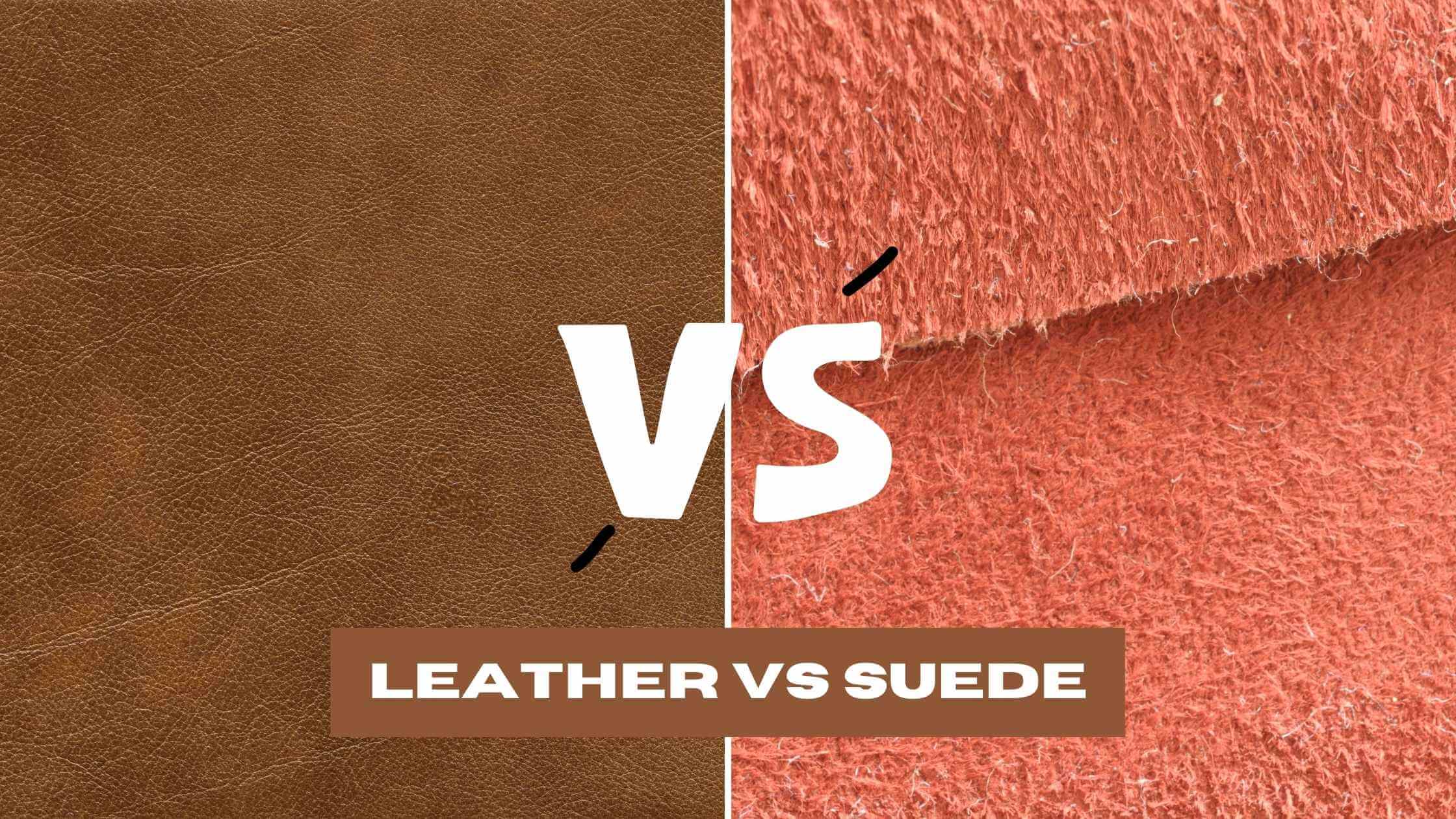There’s some sort of divide between leather and suede lovers out there. I’m here to help you understand their differences once and for all to decide what’s right for you! Here’s all you need to know about leather vs suede.
The main differences between leather and suede are their origin in animal skin, their texture, durability, and usability features such as waterproofing, cleaning instructions, and recommended use.
Leather and suede are often compared directly with a “which is better” attitude. Still, they are both excellent choices in their category if you ask me. Below, I’ll talk about how they perform and how to figure out which will be right for you!
Key differences between leather and suede
The best way to get a feel for how leather and suede differentiate is to compare their key differences! I’ve done that below for you:
Leather’s key features
- Exterior hide of the animal
- Smooth, buttery feeling
- Seen as more formal
- Can have some exposure to water
Suede’s key features
- Interior hide of the animal
- Soft, matte-finish, satiny feel
- Seen as more casual
- Shouldn’t have exposure to water
Pretty straightforward, right? Some leather lovers will change back and forth between leather and suede depending on what they’re going for with look, feel, and usability, and that’s what it’s all about. But I’ll get into that a bit later. Let’s take a look at understanding these differences a bit more!
How are they made differently?
You’ll get the top layer of the skin if you go for leather. Regardless of what animal it came from (cowhide is the most common), leather includes the top layer of skin, and then it’s tanned and dyed, etc.
On the other hand, suede comes from the interior layer of an animal’s skin that is stripped away from the top protective layer. It sounds gross when you think of it that way, but stay with me! Suede will still be tanned and dyed, just like leather would be.
The main differences between them when it comes to the part of skin they’re made from are the texture and the durability. Leather is more durable, tough, and silky or buttery. Suede is a bit weaker, textured, and satiny or fuzzy.
Pros and cons of leather and suede
Realistically speaking, leather and suede have their pros and cons. Of course, cons on one would translate to pros on the other type, and vice versa! Let’s look at the pros and cons and see just how these types of leather are so impressive.
Pros of leather
- Tough and great for resisting wear and tear
- Can be dyed any color
- Can last 10+ years with proper care
- Dresses up every outfit
- Smells amazing
Cons of leather
- Requires regular cleaning and conditioning
- Scratches or rips show easily and is challenging to repair
Pros of suede
- Soft and textured matte finish
- More breathable than leather
- Can be dyed any color
- Can last for 10+ years with proper care
- Great for casual wear but still looks nice
- Small dings, scratches, etc., can be buffed out
Cons of suede
- Requires brushing and waterproofing often
- Doesn’t have a natural resistance to weather or the elements
Seeing the pros and cons line up so neatly like this is neat. As you can also see, there isn’t a clear winner here. They’re both unique and have significant advantages and essential disadvantages to consider.
One of my favorite features is just how versatile suede is when it comes to any “oopsy” moments. Both leather and suede have the same durability, but suede can hide scratches or natural imperfections because you can (and should) brush the nap easily. Leather’s smooth and buttery surface doesn’t have that luxury. As an accident-prone leather lover, I feel like suede is made for people like me!
Is leather or suede a stronger material?
Leather and suede have the same durability. But if you get into details of tensile strength, leather wins. It has the tough, protective outer layer of the hide that suede doesn’t. That gives the leather the edge over the competition.
Is leather or suede more expensive?
There is a toss-up here, depending on who you ask. Many declare that leather is more expensive than suede to the longer tanning and prep process of leather. However, others will tell you that suede is more expensive since splitting the top layer from the inner layer (which is required for creating suede) takes longer and costs more.
The other factor is that you can get more suede from a piece of hide than leather. Since suede is easier to produce, it costs less than leather.
Fun Fact: The prices should be comparative between leather and suede. If one is noticeably lower than the other, you might be looking at an imitation!
Is leather or suede easier to clean?
Leather has many products you can use to clean, condition, and protect it. These include commercial products and DIY options for cleaning leather.
Is leather or suede better for rain?
If you remember from what I listed above, you’ll suspect that leather will be better for wearing in the rain than suede, right? And you’d be correct! Leather is going to be much better for rain compared to standard suede.
Notice how I mentioned “normal” suede. There is an exception, and that’s CF Stead suede. This suede has a unique tanning process that blends Scotchgard into the suede, providing impressive waterproofing abilities to that suede.
This waterproofed suede will be better than classic leather and much better than classic suede. Ensure that you purchase the unique, expensive CF Stead suede since traditional suede is very different!
You can treat your suede products with a waterproofing agent to help protect them, but you’ll still want to avoid wearing them in stormy weather.
When should you use leather or suede?
For most, it’s really about personal preference. Some love leather in both casual and formal situations. Others firmly believe that suede is informal, whereas leather is formal. If you’re new to the world of leather and/or suede, get a feel for how you like each type and go with what feels best for you.
Generally, leather offers better protection against the wind and harsh weather. Suede will offer better protection, specifically against humidity and overall moisture in the air.
Suede also works well as a warm and toast liner underneath your external winter wear, so this is a huge perk for those that want to wear their suede all year round.
Interestingly, despite its weakness to the cold and water, Statista reports that of those who bought winter gear for the UK (traditionally wet and cold), 69% bought leather or suede boots!
Which is better: suede or leather?
You can probably guess by now that’s there no clear winner if you put these two unique types of leather head to head. When you see it laid out like this, it’s pretty easy to understand how leather and suede are different in a generic way. But what about comparing them in the store and wondering which will be best for your lifestyle? The easy answer is whichever you feel suits your needs for style, texture, and overall care and maintenance.
Think about details such as whether you want the top grain of the leather to protect against the wind and light right. Compare the smooth buttery texture of the soft, satiny suede texture. Think about real-life details such as the formal vs. informal use and details that focus on the differences in brushing or not brushing. Choose the leather type that is going to best suit your personal preferences.
If you know someone debating between these two types or even need to be more informed on how suede and leather differentiate, share this with them to set them straight!

